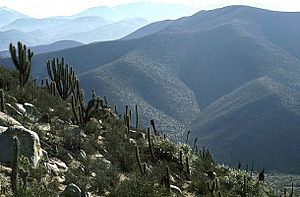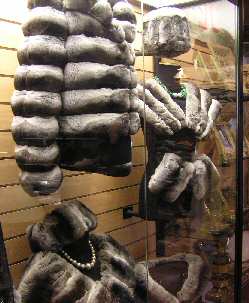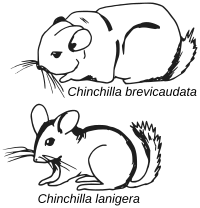Chinchillas facts for kids
Quick facts for kids ChinchillaTemporal range: Late Oligocene - Recent
|
|
|---|---|
 |
|
| Scientific classification | |
| Kingdom: | |
| Phylum: | |
| Class: | |
| Order: | |
| Family: |
Chinchillidae
Bennett, 1833
|
| Genus: |
Chinchilla
Bennett, 1829
|
| Species | |
Chinchillas are small, furry animals that are active mostly at dawn and dusk. They are a type of rodent. There are two main kinds, or species, of chinchillas: the long-tailed chinchilla (Chinchilla lanigera) and the short-tailed chinchilla (Chinchilla chinchilla).
Chinchillas are a bit bigger than ground squirrels. They come from the Andes mountains in South America. These animals live in groups called "herds" high up in the mountains, sometimes as high as 4,270 meters (14,000 feet)! Long ago, chinchillas lived in many parts of South America, like Bolivia, Peru, Argentina, and Chile. But today, you can only find wild chinchilla groups in Chile. Chinchillas are related to viscachas and chinchilla rats.
Chinchillas have the thickest fur of all land mammals. Only the sea otter has denser fur in the water. The name "chinchilla" comes from the Chincha culture of the Andes, who used to wear their soft, velvet-like fur. By the late 1800s, chinchillas became very rare because people hunted them for their fur. Most chinchillas used for fur today are raised on farms. Some chinchillas, usually from the C. lanigera species, are also kept as pets.
In 2023, it was thought that there were between 2 million and 20 million chinchillas around the world.
Contents
Where Chinchillas Live

Chinchillas used to live along the coasts, hills, and mountains of Chile, Peru, Argentina, and Bolivia. But too much hunting caused their numbers to drop a lot. As early as 1914, some scientists worried they might disappear forever.
Even after a lot of searching in Argentina, no wild chinchillas were found in one area for five years. In Chile, people thought they were gone by 1953. But then, some were found in the Antofagasta Region in the late 1900s and early 2000s. Chinchillas might be gone from Bolivia and Peru, though one was seen in a restaurant in Cerro de Pasco. It might have come from a wild group.
In their natural homes, chinchillas live in burrows or cracks in rocks. They are great jumpers and can leap up to 1.8 meters (6 feet) high!
Wild chinchillas live in social groups called herds. These herds can have from 14 to 100 members. Living in a group helps them interact and stay safe from predators. They can have babies at any time of the year. Their pregnancy lasts 111 days, which is longer than most rodents. Because of this long wait, baby chinchillas are born with fur and their eyes open. Usually, only two babies are born at a time.
What Chinchillas Eat
In the wild, chinchillas eat plant leaves, fruits, seeds, and even small insects.
When they are pets, they eat special food pellets, different kinds of hay, and a few rare treats.
Chinchilla Predators
Animals that hunt chinchillas in the wild include birds of prey, skunks, wild cats, snakes, and wild dogs. Chinchillas have ways to protect themselves. They can spray urine or release some of their fur if they are bitten.
Protecting Chinchillas
Both types of chinchillas are now listed as Endangered by the IUCN Red List. This means their numbers have dropped by about 90% in the last 15 years. This big drop happened because humans hunted chinchillas too much.
Before 1996, they were not considered at risk. But by 2008, they were "Critically Endangered," meaning they were very close to disappearing. In 2016, they were reclassified as "Endangered" because their numbers showed a small recovery in some places.
Chinchillas and Humans
Chinchilla Fur
People have been trading chinchilla fur since the 1500s. Their fur is very popular because it feels incredibly soft. This is because about 60 hairs grow from each single hair spot on their skin! The fur usually has a very even color, which makes it good for small clothes or for lining bigger clothes. Sometimes, whole coats are made from chinchilla fur.
A single long coat made from chinchilla fur can need as many as 150 pelts (skins), because chinchillas are small. Hunting them for fur led to one species disappearing and put a lot of pressure on the other two. Even though it's against the law to hunt wild chinchillas, they are still almost extinct because of continued illegal hunting. Chinchillas raised on farms are still used for fur.
Chinchillas as Pets
Chinchillas are popular pets, but they need a lot of care. Only people who know a lot about pets and their needs should get a chinchilla.
Chinchillas need plenty of exercise and special dental care. Their teeth grow all the time, throughout their lives. Also, they cannot sweat, so their living temperature must be carefully controlled.
Chinchillas cannot burp or throw up. They need special care to make sure they don't get bloated.
Their cage should be kept where the temperature is between 15 and 21 degrees Celsius (60 to 70 degrees Fahrenheit). Always put their cage in a bright area, but keep it out of direct sunlight or cold drafts.
These animals naturally clean their fur by taking "dust baths." They roll around in special dust made of fine pumice a few times a week. They do not bathe in water. If they get wet, they should be dried right away. Otherwise, their fur can grow fungus and they might get a skin infection. Their thick fur helps keep away parasites like fleas and reduces loose fur.
Types of Chinchilla Species
There are two species of chinchilla: the short-tailed chinchilla (Chinchilla brevicaudata) and the long-tailed chinchilla (Chinchilla lanigera). The differences between them are small. Right now, the short-tailed chinchilla seems to be facing extinction. The long-tailed chinchilla can still be found in the wild, but it is rare. Pet chinchillas usually come from the lanigera species.
Images for kids
-
A short-tailed chinchilla, classified as "Endangered" by the IUCN, in Chile in 2007
See also
 In Spanish: Chinchillas para niños
In Spanish: Chinchillas para niños






